engine YAMAHA TMAX 2015 User Guide
[x] Cancel search | Manufacturer: YAMAHA, Model Year: 2015, Model line: TMAX, Model: YAMAHA TMAX 2015Pages: 112, PDF Size: 6.38 MB
Page 31 of 112
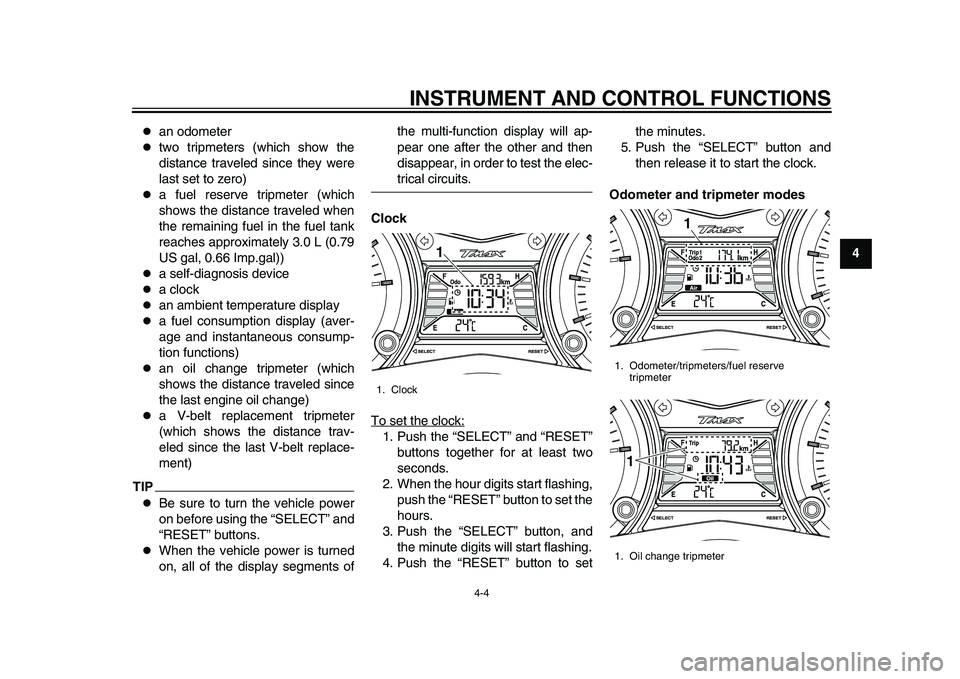
INSTRUMENT AND CONTROL FUNCTIONS
4-4
1
2
345
6
7
8
9
10
11
12
an odometer
two tripmeters (which show the
distance traveled since they were
last set to zero)
a fuel reserve tripmeter (which
shows the distance traveled when
the remaining fuel in the fuel tank
reaches approximately 3.0 L (0.79
US gal, 0.66 Imp.gal))
a self-diagnosis device
a clock
an ambient temperature display
a fuel consumption display (aver-
age and instantaneous consump-
tion functions)
an oil change tripmeter (which
shows the distance traveled since
the last engine oil change)
a V-belt replacement tripmeter
(which shows the distance trav-
eled since the last V-belt replace-
ment)
TIP
Be sure to turn the vehicle power
on before using the “SELECT” and
“RESET” buttons.
When the vehicle power is turned
on, all of the display segments of the multi-function display will ap-
pear one after the other and then
disappear, in order to test the elec-
trical circuits.
Clock
To set the clock:
1. Push the “SELECT” and “RESET” buttons together for at least two
seconds.
2. When the hour digits start flashing, push the “RESET” button to set the
hours.
3. Push the “SELECT” button, and the minute digits will start flashing.
4. Push the “RESET” button to set the minutes.
5. Push the “SELECT” button and then release it to start the clock.
Odometer and tripmeter modes1. Clock
1
1. Odometer/tripmeters/fuel reserve tripmeter
1. Oil change tripmeter
1
1
2PW-9-E0_1.book 4 ページ 2015年2月19日 木曜日 午後3時30分
Page 32 of 112
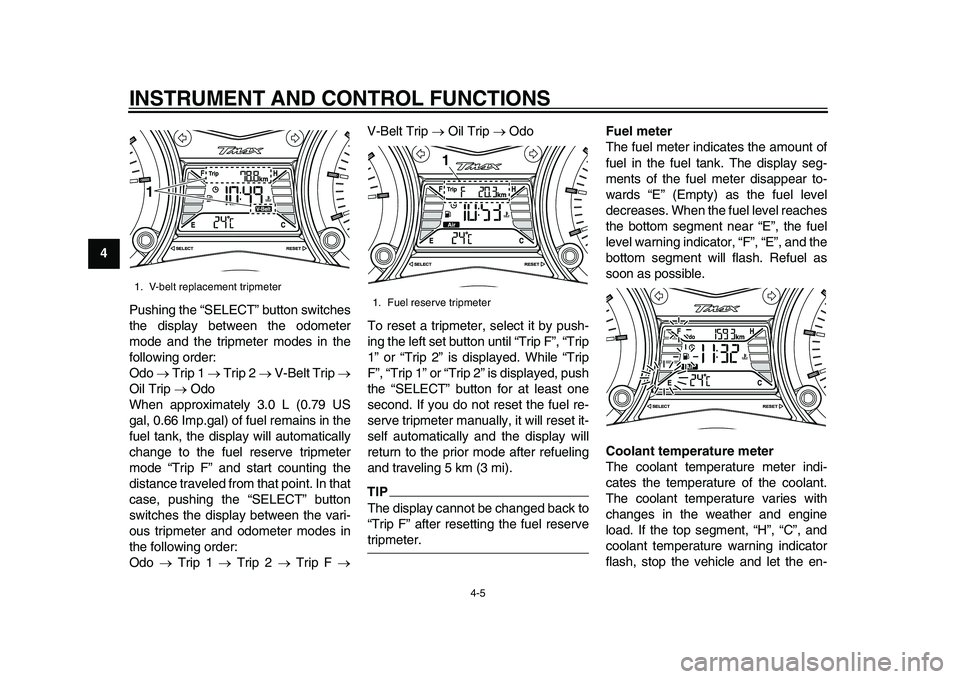
INSTRUMENT AND CONTROL FUNCTIONS
4-5
1
2
34
5
6
7
8
9
10
11
12 Pushing the “SELECT” button switches
the display between the odometer
mode and the tripmeter modes in the
following order:
Odo
Trip 1 Trip 2 V-Belt Trip
Oil Trip Odo
When approximately 3.0 L (0.79 US
gal, 0.66 Imp.gal) of fuel remains in the
fuel tank, the display will automatically
change to the fuel reserve tripmeter
mode “Trip F” and start counting the
distance traveled from that point. In that
case, pushing the “SELECT” button
switches the display between the vari-
ous tripmeter and odometer modes in
the following order:
Odo Trip 1 Trip 2 Trip F V-Belt Trip
Oil Trip Odo
To reset a tripmeter, select it by push-
ing the left set button until “Trip F”, “Trip
1” or “Trip 2” is displayed. While “Trip
F”, “Trip 1” or “Trip 2” is displayed, push
the “SELECT” button for at least one
second. If you do not reset the fuel re-
serve tripmeter manually, it will reset it-
self automatically and the display will
return to the prior mode after refueling
and traveling 5 km (3 mi).
TIPThe display cannot be changed back to
“Trip F” after resetting the fuel reservetripmeter. Fuel meter
The fuel meter indicates the amount of
fuel in the fuel tank. The display seg-
ments of the fuel meter disappear to-
wards “E” (Empty) as the fuel level
decreases. When the fuel level reaches
the bottom segment near “E”, the fuel
level warning indicator, “F”, “E”, and the
bottom segment will flash. Refuel as
soon as possible.
Coolant temperature meter
The coolant temperature meter indi-
cates the temperature of the coolant.
The coolant temperature varies with
changes in the weather and engine
load. If the top segment, “H”, “C”, and
coolant temperature warning indicator
flash, stop the vehicle and let the en-
1. V-belt replacement tripmeter1
1. Fuel reserve tripmeter
1
2PW-9-E0_1.book 5 ページ 2015年2月19日 木曜日 午後3時30分
Page 33 of 112
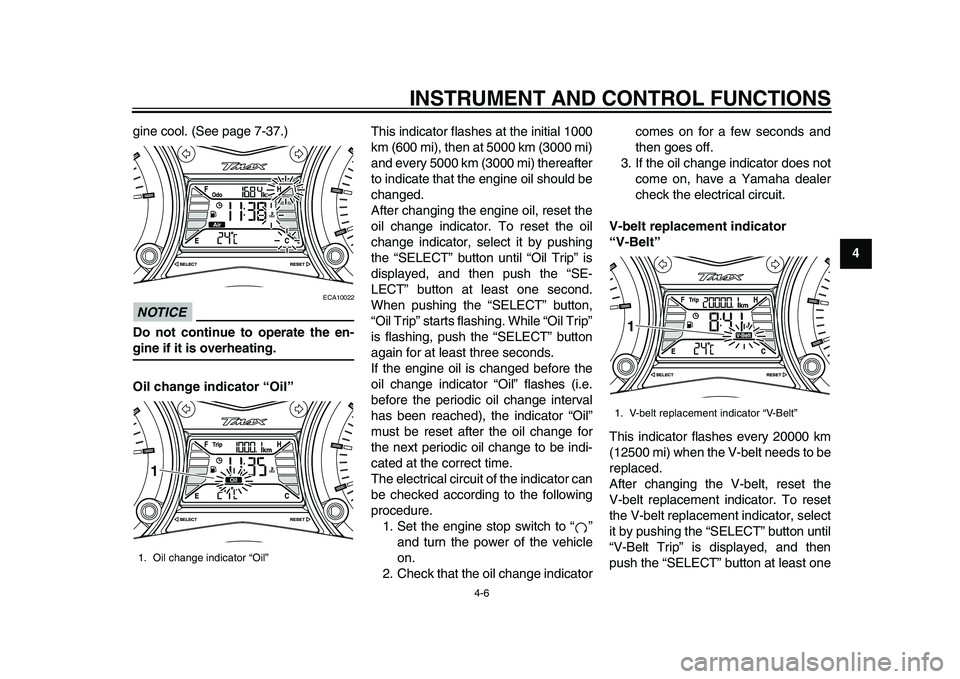
INSTRUMENT AND CONTROL FUNCTIONS
4-6
1
2
345
6
7
8
9
10
11
12
gine cool. (See page 7-37.)
NOTICE
ECA10022
Do not continue to operate the en-gine if it is overheating.
Oil change indicator “Oil”
This indicator flashes at the initial 1000
km (600 mi), then at 5000 km (3000 mi)
and every 5000 km (3000 mi) thereafter
to indicate that the engine oil should be
changed.
After changing the engine oil, reset the
oil change indicator. To reset the oil
change indicator, select it by pushing
the “SELECT” button until “Oil Trip” is
displayed, and then push the “SE-
LECT” button at least one second.
When pushing the “SELECT” button,
“Oil Trip” starts flashing. While “Oil Trip”
is flashing, push the “SELECT” button
again for at least three seconds.
If the engine oil is changed before the
oil change indicator “Oil” flashes (i.e.
before the periodic oil change interval
has been reached), the indicator “Oil”
must be reset after the oil change for
the next periodic oil change to be indi-
cated at the correct time.
The electrical circuit of the indicator can
be checked according to the following
procedure.
1. Set the engine stop switch to “ ” and turn the power of the vehicle
on.
2. Check that the oil change indicator comes on for a few seconds and
then goes off.
3. If the oil change indicator does not come on, have a Yamaha dealer
check the electrical circuit.
V-belt replacement indicator
“V-Belt”
This indicator flashes every 20000 km
(12500 mi) when the V-belt needs to be
replaced.
After changing the V-belt, reset the
V-belt replacement indicator. To reset
the V-belt replacement indicator, select
it by pushing the “SELECT” button until
“V-Belt Trip” is displayed, and then
push the “SELECT” button at least one1. Oil change indicator “Oil”1
1. V-belt replacement indicator “V-Belt”1
2PW-9-E0_1.book 6 ページ 2015年2月19日 木曜日 午後3時30分
Page 34 of 112
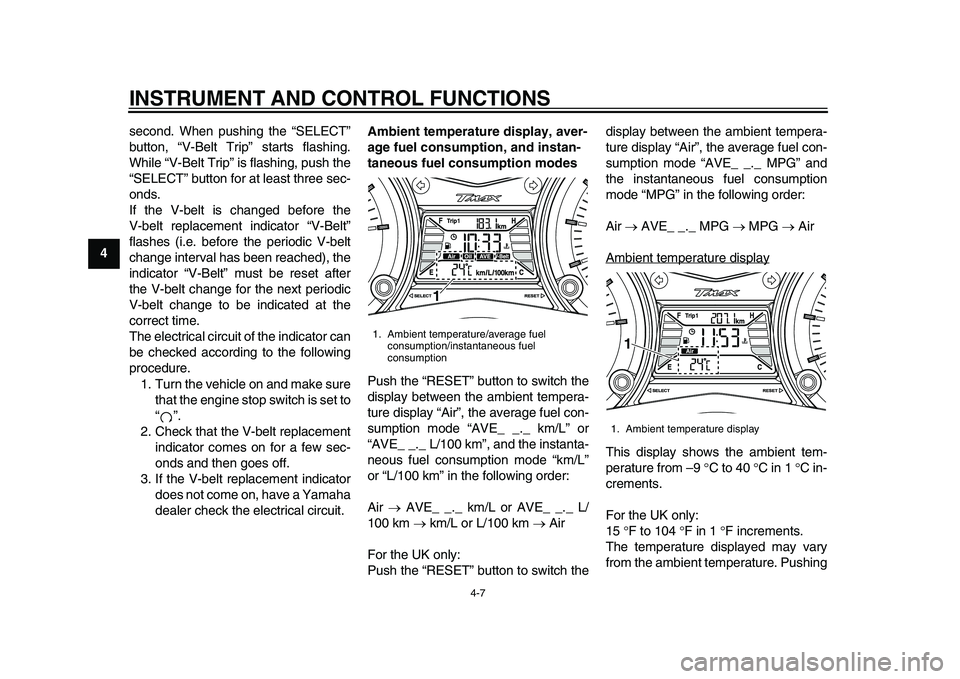
INSTRUMENT AND CONTROL FUNCTIONS
4-7
1
2
34
5
6
7
8
9
10
11
12 second. When pushing the “SELECT”
button, “V-Belt Trip” starts flashing.
While “V-Belt Trip” is flashing, push the
“SELECT” button for at least three sec-
onds.
If the V-belt is changed before the
V-belt replacement indicator “V-Belt”
flashes (i.e. before the periodic V-belt
change interval has been reached), the
indicator “V-Belt” must be reset after
the V-belt change for the next periodic
V-belt change to be indicated at the
correct time.
The electrical circuit of the indicator can
be checked according to the following
procedure.
1. Turn the vehicle on and make sure that the engine stop switch is set to
“”.
2. Check that the V-belt replacement indicator comes on for a few sec-
onds and then goes off.
3. If the V-belt replacement indicator does not come on, have a Yamaha
dealer check the el ectrical circuit.Ambient temperature display, aver-
age fuel consumption, and instan-
taneous fuel consumption modes
Push the “RESET” button to switch the
display between the ambient tempera-
ture display “Air”, the average fuel con-
sumption mode “AVE_ _._ km/L” or
“AVE_ _._ L/100 km”, and the instanta-
neous fuel consumption mode “km/L”
or “L/100 km” in the following order:
Air
AVE_ _._ km/L or AVE_ _._ L/
100 km km/L or L/100 km Air
For the UK only:
Push the “RESET” button to switch the display between the ambient tempera-
ture display “Air”, the average fuel con-
sumption mode “AVE_ _._ MPG” and
the instantaneous fuel consumption
mode “MPG” in the following order:
Air
AVE_ _._ MPG MPG Air
Ambient temperature display
This display shows the ambient tem-
perature from –9 C to 40 C in 1 C in-
crements.
For the UK only:
15 F to 104 F in 1 F increments.
The temperature displayed may vary
from the ambient temperature. Pushing
1. Ambient temperature/average fuel consumption/instantaneous fuel
consumption
1
1. Ambient temperature display1
2PW-9-E0_1.book 7 ページ 2015年2月19日 木曜日 午後3時30分
Page 36 of 112
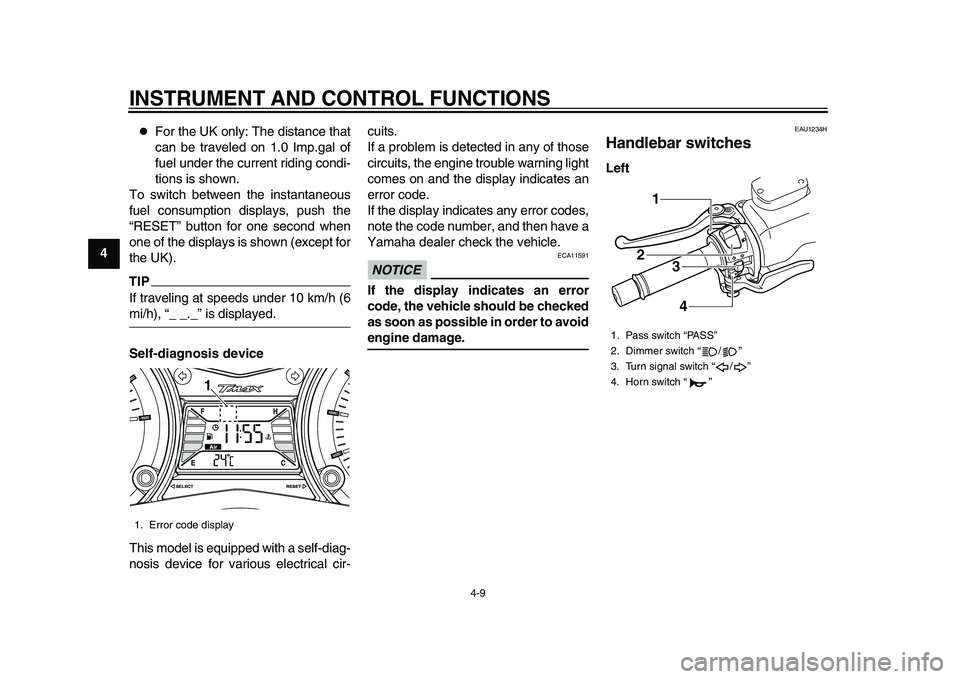
INSTRUMENT AND CONTROL FUNCTIONS
4-9
1
2
34
5
6
7
8
9
10
11
12
For the UK only: The distance that
can be traveled on 1.0 Imp.gal of
fuel under the current riding condi-
tions is shown.
To switch between the instantaneous
fuel consumption displays, push the
“RESET” button for one second when
one of the displays is shown (except for
the UK).
TIPIf traveling at speeds under 10 km/h (6mi/h), “_ _._” is displayed.
Self-diagnosis device
This model is equipped with a self-diag-
nosis device for various electrical cir- cuits.
If a problem is detected in any of those
circuits, the engine
trouble warning light
comes on and the display indicates an
error code.
If the display indicates any error codes,
note the code number, and then have a
Yamaha dealer check the vehicle.
NOTICE
ECA11591
If the display indicates an error
code, the vehicle should be checked
as soon as possible in order to avoidengine damage.
EAU1234H
Handlebar switchesLeft
1. Error code display
1
1. Pass switch “PASS”
2. Dimmer switch “ / ”
3. Turn signal switch “ / ”
4. Horn switch “ ”
1
2
3
4
2PW-9-E0_1.book 9 ページ 2015年2月19日 木曜日 午後3時30分
Page 37 of 112
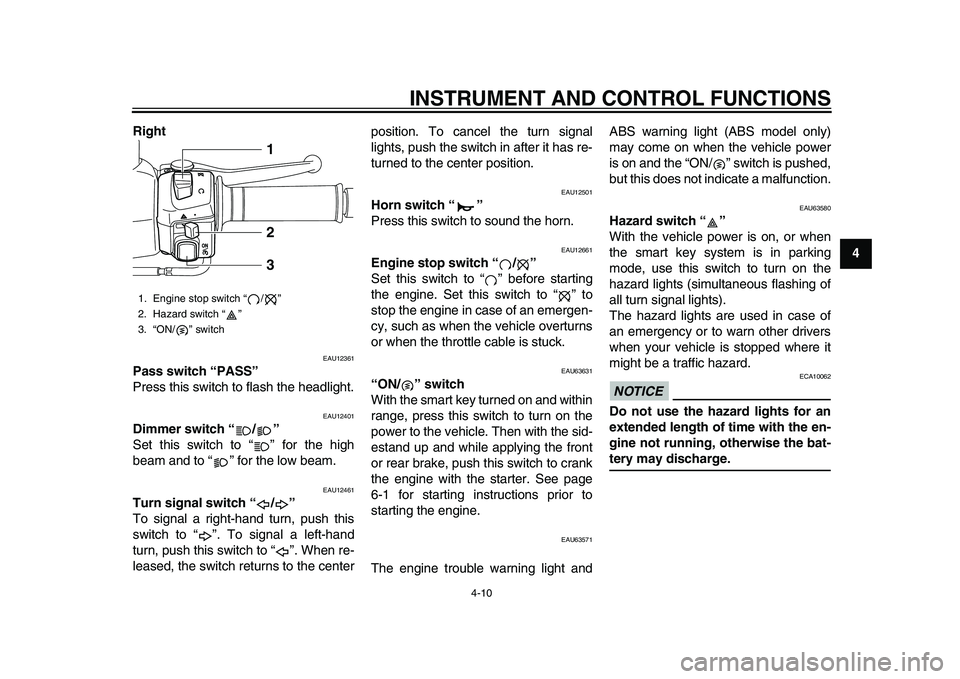
INSTRUMENT AND CONTROL FUNCTIONS
4-10
1
2
345
6
7
8
9
10
11
12
Right
EAU12361
Pass switch “PASS”
Press this switch to flash the headlight.
EAU12401
Dimmer switch “ / ”
Set this switch to “ ” for the high
beam and to “ ” for the low beam.
EAU12461
Turn signal switch “ / ”
To signal a right-hand turn, push this
switch to “ ”. To signal a left-hand
turn, push this switch to “ ”. When re-
leased, the switch returns to the center position. To cancel the turn signal
lights, push the switch in after it has re-
turned to the center position.
EAU12501
Horn switch “ ”
Press this switch to sound the horn.
EAU12661
Engine stop switch “ / ”
Set this switch to “ ” before starting
the engine. Set this switch to “ ” to
stop the engine in case of an emergen-
cy, such as when the vehicle overturns
or when the throttle cable is stuck.
EAU63631
“ON/ ” switch
With the smart key turned on and within
range, press this switch to turn on the
power to the vehicle. Then with the sid-
estand up and while applying the front
or rear brake, push this switch to crank
the engine with the starter. See page
6-1 for starting instructions prior to
starting the engine.
EAU63571
The engine trouble warning light andABS warning light (ABS model only)
may come on when the vehicle power
is on and the “ON/ ” switch is pushed,
but this does not indicate a malfunction.
EAU63580
Hazard switch “ ”
With the vehicle power is on, or when
the smart key system is in parking
mode, use this switch to turn on the
hazard lights (simultaneous flashing of
all turn signal lights).
The hazard lights are used in case of
an emergency or to warn other drivers
when your vehicle is stopped where it
might be a traffic hazard.NOTICE
ECA10062
Do not use the hazard lights for an
extended length of time with the en-
gine not running, otherwise the bat-tery may discharge.
1. Engine stop switch “ / ”
2. Hazard switch “ ”
3. “ON/ ” switch
1
2
3
2PW-9-E0_1.book 10 ページ 2015年2月19日 木曜日 午後3時30分
Page 42 of 112
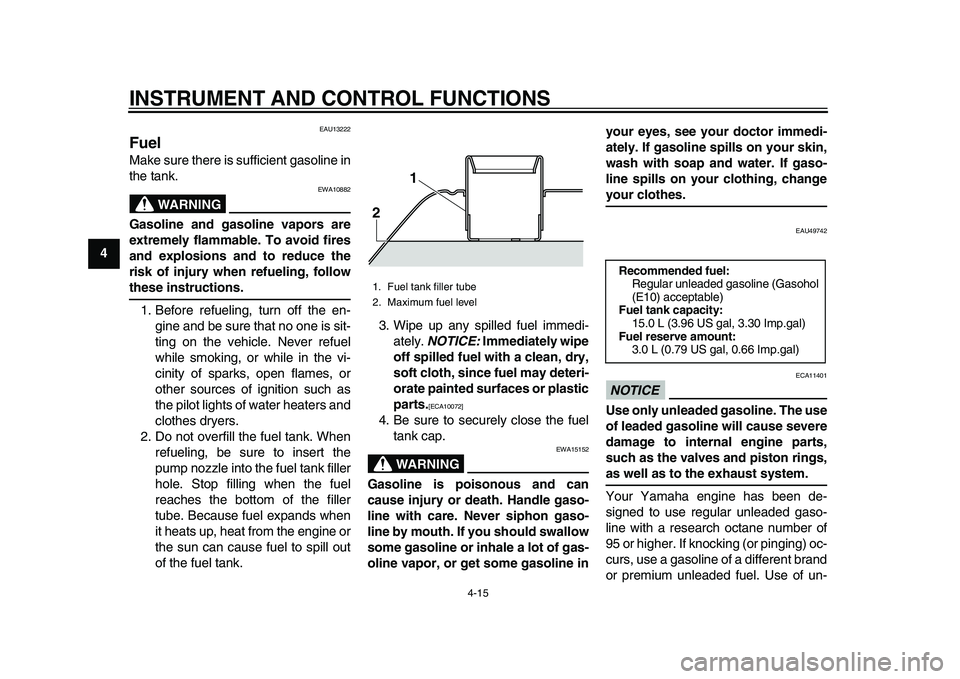
INSTRUMENT AND CONTROL FUNCTIONS
4-15
1
2
34
5
6
7
8
9
10
11
12
EAU13222
FuelMake sure there is sufficient gasoline in
the tank.
WARNING
EWA10882
Gasoline and gasoline vapors are
extremely flammable. To avoid fires
and explosions and to reduce the
risk of injury when refueling, followthese instructions. 1. Before refueling, turn off the en- gine and be sure that no one is sit-
ting on the vehicle. Never refuel
while smoking, or while in the vi-
cinity of sparks, open flames, or
other sources of ignition such as
the pilot lights of water heaters and
clothes dryers.
2. Do not overfill the fuel tank. When refueling, be sure to insert the
pump nozzle into the fuel tank filler
hole. Stop filling when the fuel
reaches the bottom of the filler
tube. Because fuel expands when
it heats up, heat from the engine or
the sun can cause fuel to spill out
of the fuel tank. 3. Wipe up any spilled fuel immedi-
ately. NOTICE: Immediately wipe
off spilled fuel with a clean, dry,
soft cloth, since fuel may deteri-
orate painted surfaces or plastic
parts.
[ECA10072]
4. Be sure to securely close the fuel tank cap.
WARNING
EWA15152
Gasoline is poisonous and can
cause injury or death. Handle gaso-
line with care. Never siphon gaso-
line by mouth. If you should swallow
some gasoline or inhale a lot of gas-
oline vapor, or get some gasoline in your eyes, see your doctor immedi-
ately. If gasoline spills on your skin,
wash with soap and water. If gaso-
line spills on your clothing, change
your clothes.
EAU49742
NOTICE
ECA11401
Use only unleaded gasoline. The use
of leaded gasoline will cause severe
damage to internal engine parts,
such as the valves and piston rings,as well as to the exhaust system.
Your Yamaha engine has been de-
signed to use regular unleaded gaso-
line with a research octane number of
95 or higher. If knocking (or pinging) oc-
curs, use a gasoline of a different brand
or premium unleaded fuel. Use of un-
1. Fuel tank filler tube
2. Maximum fuel level2
1
Recommended fuel:
Regular unleaded gasoline (Gasohol
(E10) acceptable)
Fuel tank capacity: 15.0 L (3.96 US gal, 3.30 Imp.gal)
Fuel reserve amount:
3.0 L (0.79 US gal, 0.66 Imp.gal)
2PW-9-E0_1.book 15 ページ 2015年2月19日 木曜日 午後3時30分
Page 43 of 112
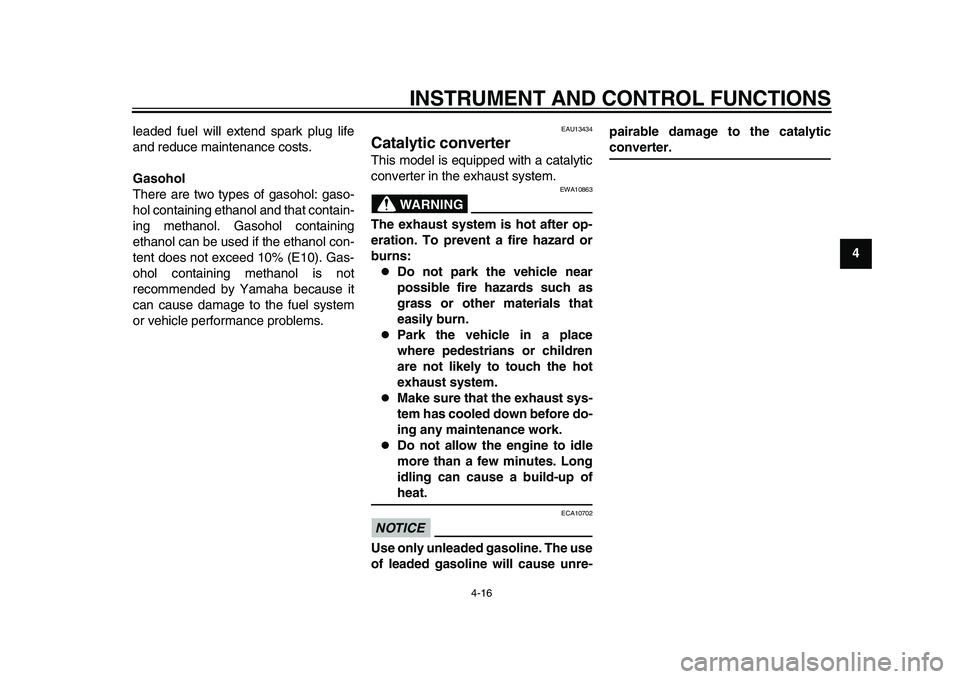
INSTRUMENT AND CONTROL FUNCTIONS
4-16
1
2
345
6
7
8
9
10
11
12
leaded fuel will extend spark plug life
and reduce maintenance costs.
Gasohol
There are two types of gasohol: gaso-
hol containing ethanol and that contain-
ing methanol. Gasohol containing
ethanol can be used if the ethanol con-
tent does not exceed 10% (E10). Gas-
ohol containing methanol is not
recommended by Yamaha because it
can cause damage to the fuel system
or vehicle performance problems.
EAU13434
Catalytic converterThis model is equipped with a catalytic
converter in the exhaust system.
WARNING
EWA10863
The exhaust system is hot after op-
eration. To prevent a fire hazard or
burns:
Do not park the vehicle near
possible fire hazards such as
grass or other materials that
easily burn.
Park the vehicle in a place
where pedestrians or children
are not likely to touch the hot
exhaust system.
Make sure that the exhaust sys-
tem has cooled down before do-
ing any maintenance work.
Do not allow the engine to idle
more than a few minutes. Long
idling can cause a build-up ofheat.
NOTICE
ECA10702
Use only unleaded gasoline. The use
of leaded gasoline will cause unre- pairable damage to the catalytic
converter.
2PW-9-E0_1.book 16 ページ 2015年2月19日 木曜日 午後3時30分
Page 50 of 112
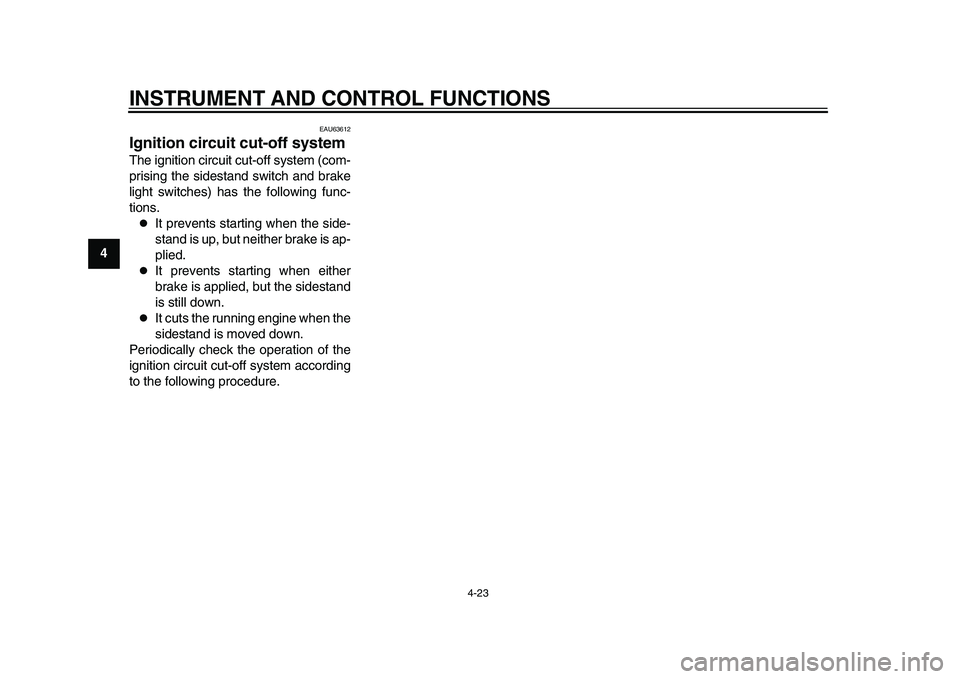
INSTRUMENT AND CONTROL FUNCTIONS
4-23
1
2
34
5
6
7
8
9
10
11
12
EAU63612
Ignition circuit cut-off systemThe ignition circuit cut-off system (com-
prising the sidestand switch and brake
light switches) has the following func-
tions.
It prevents starting when the side-
stand is up, but neither brake is ap-
plied.
It prevents starting when either
brake is applied, but the sidestand
is still down.
It cuts the running engine when the
sidestand is moved down.
Periodically check the operation of the
ignition circuit cut-off system according
to the following procedure.
2PW-9-E0_1.book 23 ページ 2015年2月19日 木曜日 午後3時30分
Page 51 of 112
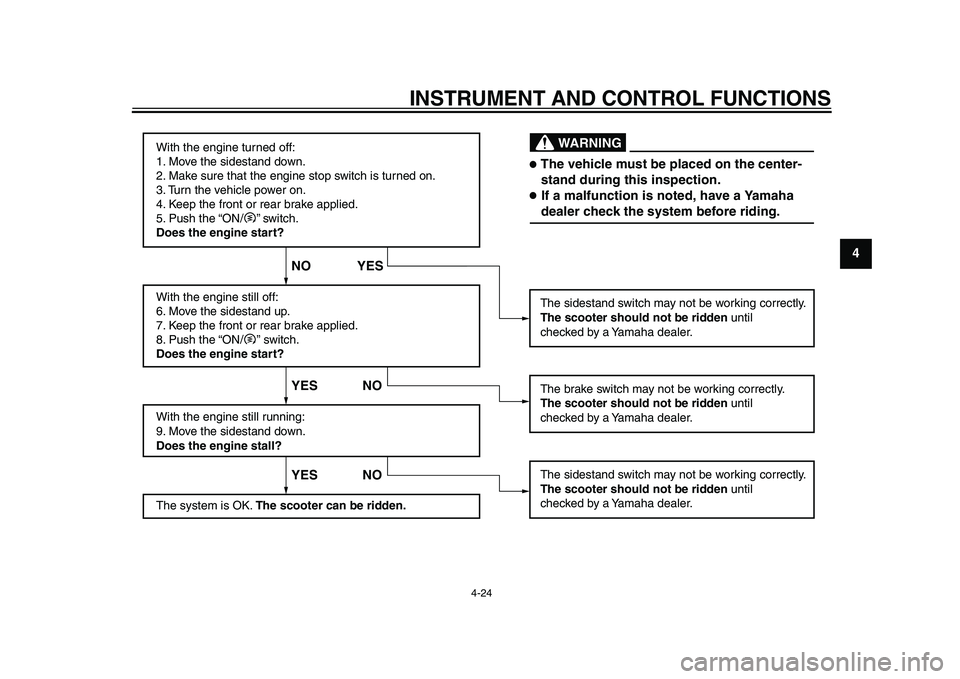
INSTRUMENT AND CONTROL FUNCTIONS
4-24
1
2
345
6
7
8
9
10
11
12
With the engine turned off:
1. Move the sidestand down.
2. Make sure that the engine stop switch is turned on.
3. Turn the vehicle power on.
4. Keep the front or rear brake applied.
5. Push the “ON/ ” switch.
Does the engine start?
With the engine still off:
6. Move the sidestand up.
7. Keep the front or rear brake applied.
8. Push the “ON/ ” switch.
Does the engine start?
With the engine still running:
9. Move the sidestand down.
Does the engine stall?
The system is OK. The scooter can be ridden. The sidestand switch may not be working correctly.
The scooter should not be ridden until
checked by a Yamaha dealer.
The sidestand switch may not be working correctly.
The scooter should not be ridden until
checked by a Yamaha dealer.
YES NO YES NO NO YES
The brake switch may not be working correctly.
The scooter should not be ridden until
checked by a Yamaha dealer.The vehicle must be placed on the center-
stand during this inspection. If a malfunction is noted, have a Yamaha
dealer check the system before riding.
WARNING
2PW-9-E0_1.book 24 ページ 2015年2月19日 木曜日 午後3時30分